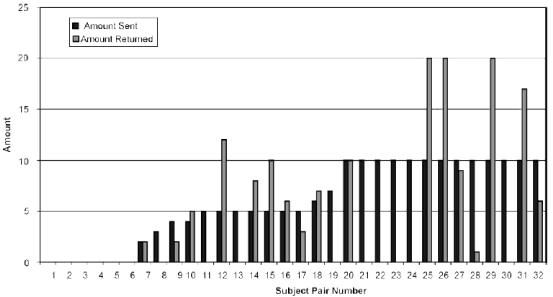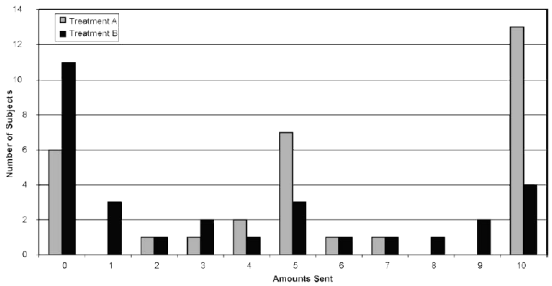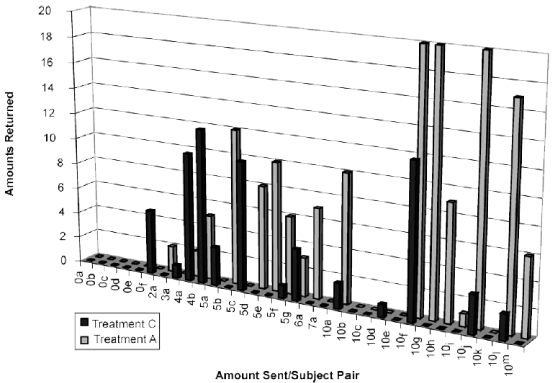|
|
|
James Cox in "How to Identify Trust and Reciprocity," Games and Economic Behavior, 46, 2004, pp. 260-281, introduces a triadic (three-games) design for conducting trust and reciprocity experiments. As Cox notes, most of game theory assumes that only payoffs matter and that relative or absolute material payoffs and intentions of other players do not play a role. A large body of experimental literature has produced results inconsistent with predictions of self-regarding preferences model. The triadic design implemented in the study discriminates between actions motivated by preferences over the distribution of material outcomes and actions motivated by attributions of the intentions of others.
|
|
Teaching Module
|
|
The large literature on single-game trust and reciprocity experiments with one-shot games is based on the assumption that a subject's utility payoff in a game is the same as his/her monetary payoff. Experiments with the triadic design can discriminate between transfers resulting from trust and transfers resulting from other-regarding preferences for player 1 and between transfers resulting from positive reciprocity and transfers resulting from other-regarding preferences for player 2.
|
|
Cox's experiment includes three games implemented in an across subject design:
- Treatment A: Investment Game
- Treatment B: Investment Game Dictator Control 1 (IGDC1)
- IGDC1 is a dictator game that differs from treatment A only in that the players 2 have no decision to make, thus do not have an opportunity to return any money that they receives.
- Treatment C: Investment Game Dictator Control 2 (IGDC2) is a dictator game with the following features:
- Players 1 do not make a decision.
- Players 1 are given an endowment in amount kept by players 1 in treatment A.
- Players 2 are given a $10 endowment plus additional amount equal to an amount received by players 2 in treatment A from the tripled amounts sent by players 1 in treatment A.
- The subjects are informed with a table of the exact inverse relation between the number of additional dollars received by a player 2 and the endowment of the anonymously-paired player 1.
- The subjects are not informed that their endowments were determined by players' 1 decisions in the investment game.
- Players 2 are given the opportunity to give money to their anonymously-paired players 1. Each dollar that a player 2 gives to player 1 costs the giver one dollar, as in the investment game.
|
|
The experiment sessions were run manually with a double blind payoff procedure. Subject responses were identified only by letters that were private information of the decision makers. Monetary payoffs were collected in private from sealed envelopes contained in lettered mailboxes. This way no one, neither the experimenters nor the other subjects nor anyone else would ever be able to trace the subjects' choices to their identities.
|
|
Other-regarding preferences are preferences over the absolute and relative amount of another individual's material payoffs, in addition to one's own material payoffs.
Trust is inherently a matter of the beliefs that one agent has about the behavior of another. An action that is trusting of another is one that creates the possibility of mutual benefit, if the person is cooperative, and the risk of loss to oneself if the other person defects.
Positive reciprocity is a motivation to repay generous or helpful actions of another by adopting actions that are generous or helpful to the other person.
|
|
If player 1 decides to send a positive amount of money, it does not necessarily mean that she exhibits trusting behavior, unless it is known that she has self-regarding or inequality-averse preferences. Alternative explanation of sending a positive amount to the second mover are altruistic preferences. In such case, player 1 might prefer to give some money regardless of how much, if any, player 2 might return. Notice that in treatment B, player 2 cannot return anything to player 1. Consequently, player 1's transfer cannot be motivated by trust. The conclusions abouth whether players' 1 choices in treatment A investment game are partially motivated by trust are based on the difference between the amounts sent by players 1 to players 2 in treatments A and B.
|
|
There are two possibilities why player 2 may return part of the tripled money to the paired player 1. One explanation are the preferences over payoff pairs conditional on a social norm for reciprocating the intentionally generous behavior of the first mover. By returning some or all money, player 2 repays a generous action with a generous response. The other explanation for sending back a positive amount to player 1 are unconditional altruistic or inequality-averse other-regarding preferences. In treatment C players 1 cannot send anything and consequently, players 2 cannot be motivated by a positive reciprocity. Thus, the conclusions about whether players' 2 choices in treatment A investment game are partially motivated by positive reciprocity are based on the difference between the amounts returned by players 2 to players 1 in treatments A and C.
|
|
In Cox's investment game 6 out of 32 players 1 sent zero, 7 sent exactly half of their endowments, 2 sent amounts that were greater than $5 and less than $10, and 13 players 1 sent all $10 of their endowments. In the Investment Game Dictator Control 1, 19 out of 30 players 1 (i.e. 63%) sent positive amounts of money and only 11 sent zero; thus there is substantial evidence of altruistic other-regarding preferences in these data. Further statistical analysis of the data that compares the amounts sent by players 1 in IGDC1 reveals that players 1 in the experiment also exhibited trust.
|
|
Figure 1. Behavior of Subjects in The Investment Game (Treatment A)
|

|
|
Figure 2. Behavior of Subjects in The Investment Game Dictator Control 1 (Treatment B)
|

|
|
In the Investment Game Dictator Control 2, 13 out of 32 players 2 returned positive amounts of money to paired first movers, which provides substantial evidence of other-regarding preferences also among players 2. The statistical analysis comparing amounts returned by the players 2 in the Investment Game and IGDC2 reveals that players 2 in the experiment exhibit positive reciprocity.
|
|
Figure 3. Behavior of Subjects in The Investment Game Dictator Control 2 (Treatment C)
|

|
| |